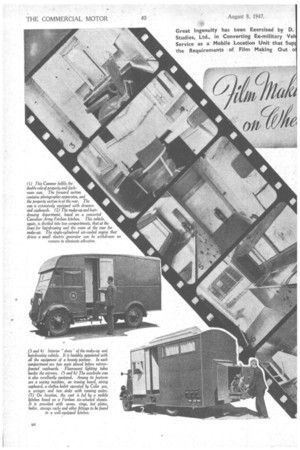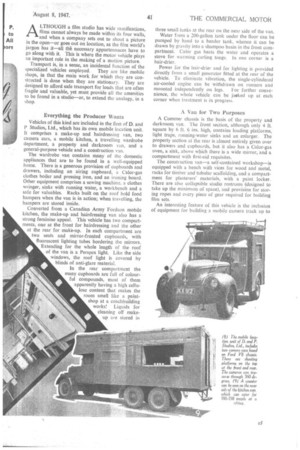Great Ingenuity has been Exercised by D. Studios, Ltd., in
Page 38

Page 39

Page 40

If you've noticed an error in this article please click here to report it so we can fix it.
Converting Ex-military Ve Service as a Mobile Location Unit that Sup the Requirements of Film Making Out o
ALTHOUGH a film studio has wide ramifications, films cannot always be made within its four walls, and when a company sets out to shoot a picture in the open—or goes out on location, as the film world's jargon has it—all flat necessary appurtenances have to go along with it. This is where the motor vehicle plays an important role in the making of a motion picture. Transport is, in a sense, an incidental function of the specialized vehicles employed. They are like mobile shops, in that the main work for which they are constructed is done when they are stationary. They are designed to afford safe transport for loads that are often fragile and valuable, yet must provide all the amenities to be found in a studio—or, to extend the analogy, in a shop.
Everything the Producer Wants
Vehicles of this kind are included in the fleet of D. and P Studios, Ltd., which has its own mobile location unit. It comprises a make-up and hairdressing van, two camera cars, a mobile kitchen, a travelling wardrobe department, a property and darkroom van, and a general-purpose vehicle and a construction van.
The wardrobe van contains many of the domestic appliances that are to be found in a well-equipped home. There is a generous provision of cupboards and drawers, including an airing cupboard, a Calor-gas clothes boiler and pressing iron, and an ironing board. Other equipment comprises a sewing machine, a clothes wringer, sinks with running water, a workbench and a safe for valuables. Racks built on the roof hold food hampers when the van is in action; when travelling, the hampers are stored inside.
Converted from a Canadian Army Fordson mobile kitchen, the make-up and hairdressing van also has a strong feminine appeal. This vehicle has two compartments, one at the front for hairdressing and the other at the rear for make-up. In each compartment are two seats and mirror-fronted cupboards, with fluorescent lighting tubes bordering the mirrors. Extending for the whole length of the roof of the van is a Perspex light. Like the side windows, the roof light is covered by blinds of anti-glare material.
In the rear compartment the many cupboards are full of colourful compounds, most of them apparently having a high cellulose content that makes the room smell like a paintshop at a coachbuilding works! Liquids for cleaning off makeup are stored in
three small tanks at the rear on the near side of the van.
Water from a 200-gallon tank under the floor can be pumped by hand to a header tank, whence it can be drawn by gravity into a shampoo basin in the front compartment. Ca lot gas heats the water and operates a stove for warming curling tongs. In one corner is a hair-drier.
Power for the hair-drier and for lighting is provided directly from a small generator fitted at the rear of the vehicle. To eliminate vibration, the single-cylindered air-cooled engine can be withdrawn on runners and
mounted independently on legs. For further convenience, the whole vehicle can be jacked up at each corner when treatment is in progress.
A Van for Two Purposes
A Commer chassis is the basis of the property and darkroom van. The front section, although only 4 ft. square by 6 ft. 6 ins, high, contains loading platforms, light traps, running-water sinks and an enlarger. The property section at the rear is almost entirely given over to drawers and cupboards, but it also has a Calor-gas oven, a sink, above which there is a wide mirror, and a compartment with first-aid requisites.
The construction van—a self-contained workshop—is equipped with a bench with vices for wood and metal, racks for timber and tubular scaffolding, and a compartment for plasterers' materials, with a paint locker. There are also collapsible studio rostrums (designed to take up the minimum of space), and provision for storing ropes and every piece of gear required for building film sets.
An interesting feature of this vehicle is the inclusion of equipment for building a mobile camera track up to 36 ft. long. If necessary, the interior of the van can be cleared for general-purpose use The camera cars are both based on ,Ford V8 chassis that were originally military scout cars. New bodies were built on them, with shooting platforms on top at the front and rear. Each car can carry a complete Technicolor crew and cameras. To enable cameras to traverse 360 degrees, the roofs of the drivers' cabs are to be made to collapse, so that the crew can shoot over the seats. There are intercommunication telephones in the cabs.
On location work, the problem of feeding all concerned was solved by the provision of a mobile tzitchen, based on a Fordson sixwheeled chassis. This vehicle has proved most welcome on night work. The interior is fitted with sinks with running water, Calor-gas ovens, rings and hotplates, a boiler, and storage racks and cupboards for crockery and utensils. It can normally cater for 100 to 150 people, and once fed 175 people at one sitting.
When scenery has to be taken to outside film sets, it can be carried on a Corntner "Queen Mary" 60-ft. articulated outfit.
The idea of building this varied fleet for outside film shooting came to Mr. Tom Copeman, transport manager at Denham Studios, three years ago. At that time, however, the war stood in the way of its development, and the idea did not begin to take -shape until the wellknown producer, Mr. Michael Power, realized the advantages that such a fleet would offer in connection with a film that he was to make.
After searching the country and visiting Ministry of Supply sales, Mr. Copeman collected the right raw material for the purpose. The design of the bodies was placed in the hands of Pinewood technical department, and, bearing in mind the suggestions collected from members of each studio section, the technicians made their drawings. The bodies were built at Denham, involving work on the part of nearly every constructional department attached to the studio organization. These vehicles cover many miles and their return calls to Denham, when they are checked ever, are infrequent and brief. Often they go abroad on location work, and the Calor-gas equipment can be connected to the town. gas system. Although small, this fleet illustrates well the determination, ingenuity and technical skill that lie behind British films. It is a measure of the intention of the British film industry to remove artificiality from motion pictures, and to produce films that "live." A.S.












































































